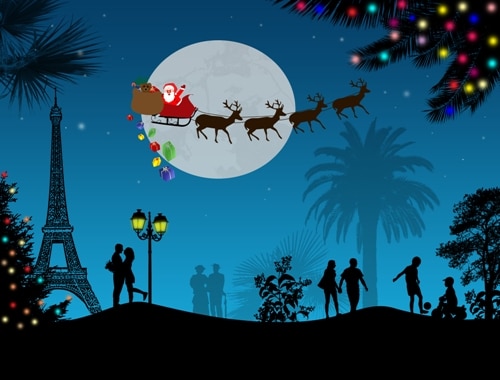
100 French Christmas Vocabulary Words
When Christmas time comes around, whether you’re in your home country or in France, you’ll want to talk about the holiday.
Here’s our list of the most used French Christmas vocabulary to add some holiday spirit to your learning.
Contents
Download: This blog post is available as a convenient and portable PDF that you can take anywhere. Click here to get a copy. (Download)
The Most Used French Christmas Vocabulary
1. Noël — Christmas
2. La fête — Celebration
3. Le sapin de Noël — Christmas tree
4. Les décorations — Decorations
5. La guirlande — Garland
6. La boule de Noël — Christmas ornament
7. L’étoile — Star
8. Le Père Noël — Father Christmas (Santa Claus)
9. La mère Noël — Mother Christmas (Mrs. Claus)
10. Les cadeaux — Gifts
11. Le traîneau — Sleigh
12. Les rennes — Reindeer
13. Le lutin — Elf
14. La cheminée — Fireplace
15. La chaussette de Noël — Christmas stocking
16. La crèche — Nativity scene
17. Les santons — Nativity figurines
18. La messe de minuit — Midnight mass
19. Le réveillon — Christmas Eve dinner
20. Les traditions — Traditions
21. Les chants de Noël — Christmas carols
22. La musique de Noël — Christmas music
23. La neige — Snow
24. Le flocon de neige — Snowflake
25. Le bonhomme de neige — Snowman
26. Les cloches — Bells
27. La couronne de Noël — Christmas wreath
28. Les lumières — Lights
29. Le marché de Noël — Christmas market
30. Les marrons — Chestnuts
31. La bûche de Noël — Yule log cake
32. La dinde — Turkey
33. Le chapon — Rooster
34. Les marrons glacés — Candied chestnuts
35. Les fruits secs — Dried fruits
36. Les chocolats — Chocolates
37. Le vin chaud — Mulled wine
38. Les biscuits de Noël — Christmas cookies
39. La cannelle — Cinnamon
40. Le pain d’épices — Gingerbread
41. Le gâteau de Noël — Christmas cake
42. Le houx — Holly
43. Le gui — Mistletoe
44. Les cloches de Noël — Christmas bells
45. La carte de vœux — Holiday card
46. La fête des Rois — Epiphany
47. Le bonnet du Père Noël — Santa hat
48. La Saint-Sylvestre — New Year’s Eve
49. L’épaule de porc — Pork shoulder
50. Le festin — Feast
51. Le Père Fouettard — Father Whipper (a scary monster character that accompanies Saint Nicolas around town before Christmas)
52. La galette des rois — King cake
53. Minuit — Midnight
54. La magie de Noël — Christmas magic
55. Le jouet — Toy
56. Les bonbons — Candies
57. Le santon — Little saint (a figurine)
58. La fête de la Nativité — Nativity feast
59. Le sapin — Fir tree
60. La chanson — Song
61. Le marché — Market
62. La veille de Noël — Christmas Eve
63. Le jour de Noël — Christmas Day
64. L’avent — Advent
65. Le calendrier de l’avent — Advent calendar
66. Le réveillon de Noël — Christmas Eve supper
67. La Saint-Nicolas — Saint Nicholas
68. Le bonnet de Noël — Santa hat
69. L’arbre de Noël — Christmas tree
70. Les illuminations — Christmas lights
71. La fête des lumières — Festival of Lights
72. La saison des fêtes — Holiday season
73. La grande roue — Ferris wheel
74. Le marché artisanal — Craft market
75. Les feux d’artifice — Fireworks
76. L’ange — Angel
77. Le sucre d’orge — Candy cane
78. La fête de fin d’année — Year-end celebration
79. La bougie — Candle
80. Le lutin de Noël — Christmas elf
81. Les enfants sages — Well-behaved children
82. Les friandises — Treats
83. Les pommes de pin — Pine cones
84. Le biscuit en pain d’épices — Gingerbread cookies
85. La pyramide de biscuits — Cookie tree
86. Les grelots — Sleigh bells
87. La hotte du Père Noël — Santa’s sack
88. Le jus de pomme chaud — Hot apple cider
89. Le chocolat chaud — Hot chocolate
90. Le petit Jésus — Baby Jesus
91. Le divin enfant — Divine Child
92. La croix de Noël — Christmas nativity cross
93. La douce nuit — Silent Night
94. La nuit sainte — Holy Night
95. Le prêtre — Priest
96. Les bergers — Shepherds
97. La Vierge Marie — Virgin Mary
98. L’esprit de Noël — Christmas spirit
99. Joyeuses fêtes — Happy holidays
100. Joyeux Noël — Merry Christmas
Celebrating Christmas in France

The Night Before Christmas
We’ve all got our own beloved family traditions when it comes to Christmas, and in France, it’s not so different. The running of events, however, does tend to happen in a slightly different order, and in many French households, it’s all about Christmas Eve.
While traditionally, the family would attend a midnight mass service on Christmas Eve, many families now partake only in the huge feast that would follow the event, which can contain up to 5 or 6 courses.
In many places, French children put out a pair of shoes on Christmas Eve in the hopes that Père Noël (Father Christmas—Santa Claus) will visit in the night to stuff them with gifts.
On Christmas Eve, the French eat le réveillon (Christmas Eve dinner). The feast is packed with some of the most incredible culinary delights seen in France. Large families tend to gather, so many courses are served over the meal. While each region has its own traditional food, many people serve goose, stuffed turkeys, chicken or oysters.
When it comes to dessert, however, many French families look to the same place for inspiration. La bûche de Noël (Yule log cake) is a well-loved Christmas dish and includes chocolate and chestnuts presented within a log-shaped cake.
Making a bûche de Noël is something that you can do at any time of year and, thanks to the Internet, there are a ton of easy and accessible recipes available!
Other areas have their own traditions, too, and if you’re lucky enough to be in Provence, you can expect to sample up to 13 desserts (celebrating Christ and his 12 disciples).
If you want to try your hand at Christmas French cooking, you’re very well covered! Books like “Celebrate Christmas à la Française” or the culinary classic “Mastering the Art of French Cooking” are packed with traditional recipes that many French people still use today.
Giving Gifts
While just like in English-speaking countries, customs do vary, it’s not unusual for children to receive gifts from extended family during the meal, saving their larger gifts from Père Noël for the day after. After all, he hasn’t visited yet!
In certain areas, however, gift giving might be a little different. More religious families in France, who celebrate la fête de Saint Nicolas (the holiday of Saint Nicholas) on the 6th of December, will give out their Christmas gifts on this day, rather than the 25th, which is instead marked with religious ceremonies and meals with the wider family.
The Last Day of Christmas: Epiphany
The time between the 24th of December and the 6th of January is packed full of celebrations in France, and if you’re in a French-speaking country with a large Christian population during this time, you can probably expect an invitation or two to a holiday party.
The last day of Christmas, Epiphany, is also celebrated in France. The day when the Three Wise Men arrived in Bethlehem after being guided by the star, it’s very important for religious families and is marked accordingly.
In the lead-up to this day, families will move their wise men figurines closer and closer to Jesus on their nativity scenes. When Epiphany finally comes around, the Wise Men are moved into the stable.
Many French families also choose to mark the day by ending their evening meal with a galette des rois (Kings’ Cake).
A pastry cake stuffed with frangipane, the galette des rois has a small figurine hidden inside that must be found. Traditionally, the youngest member of the household will hide under the dinner table and select who is going to receive each slice of the cake as it is cut into pieces.
Whoever finds the figurine in their cake gets to wear a paper crown and act as King or Queen for the night. If the family members don’t obey their every command, there will be trouble!
French Christmas Songs
Christmas songs are just as popular in France as they are elsewhere in the world, and in many cases, popular English Christmas carols have been translated into the French language!
“Vive le vent” (“Jingle Bells”) has exactly the same tune as the English version, and is a great way of brushing up on your language skills. Even “White Christmas” (“Noël Blanc”) has received the French language treatment!
Here’s a great medley of popular French Christmas songs:
If you’re lucky enough to celebrate the Christmas season in France, then you will see just how much the French people love the holiday.
From festive markets to family feasts and intricate decorations, the country is a magical place during the colder months, and no matter where you are, there’s always something worth celebrating.
If you’re staying at home, however, you can still practice French during the holiday season and incorporate some Francophile traditions into your own celebrations.
Download: This blog post is available as a convenient and portable PDF that you can take anywhere. Click here to get a copy. (Download)
And one more thing...
If you like learning French on your own time and from the comfort of your smart device, then I'd be remiss to not tell you about FluentU.
FluentU has a wide variety of great content, like interviews, documentary excerpts and web series, as you can see here:

FluentU brings native French videos with reach. With interactive captions, you can tap on any word to see an image, definition and useful examples.

For example, if you tap on the word "crois," you'll see this:

Practice and reinforce all the vocabulary you've learned in a given video with learn mode. Swipe left or right to see more examples for the word you’re learning, and play the mini-games found in our dynamic flashcards, like "fill in the blank."

All throughout, FluentU tracks the vocabulary that you’re learning and uses this information to give you a totally personalized experience. It gives you extra practice with difficult words—and reminds you when it’s time to review what you’ve learned.
Start using the FluentU website on your computer or tablet or, better yet, download the FluentU app from the iTunes or Google Play store. Click here to take advantage of our current sale! (Expires at the end of this month.)



